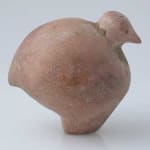Bird stamp seal, 4000 BCE - 3000 BCE
Dickite stone
3 x 2.5
D.0065
Further images
Dickite is a clay mineral named after the metallurgical chemist Allan Brugh Dick, who first described it. It is chemically composed of 20.90% aluminium, 21.76% silicon, 1.56% hydrogen and 55.78%...
Dickite is a clay mineral named after the metallurgical chemist Allan Brugh Dick, who first described it. It is chemically composed of 20.90% aluminium, 21.76% silicon, 1.56% hydrogen and 55.78% oxygen and it sometimes contains impurities such as titanium, iron, magnesium, calcium, sodium and potassium. In 1888, Allan Brugh Dick (1833–1926), a Scottish metallurgical chemist, was on the island of Anglesey on the north-west coast of Wales, to conduct research on kaolin. Dick performed various experiments describing the clay mineral that he encountered on the island but it was not until 1931 that Clarence S. Ross and Paul F. Kerr looked closer at the mineral and concluded that it was different from the known minerals of kaolinite and nacrite, hence they named it after the first person to describe the mineral. Shaped like an abstract bird, this nesting quail stamp seal was discovered with a cache of similar artifacts along the shores of Lake Van. Evoking the dawn of Western culture, these stone seals were apparently offerings at the shrine of a local powerful nature god.
Carved with abstract simplicity but an observant eye toward nature, the stark visual appeal of this piece is timeless.
Carved with abstract simplicity but an observant eye toward nature, the stark visual appeal of this piece is timeless.







